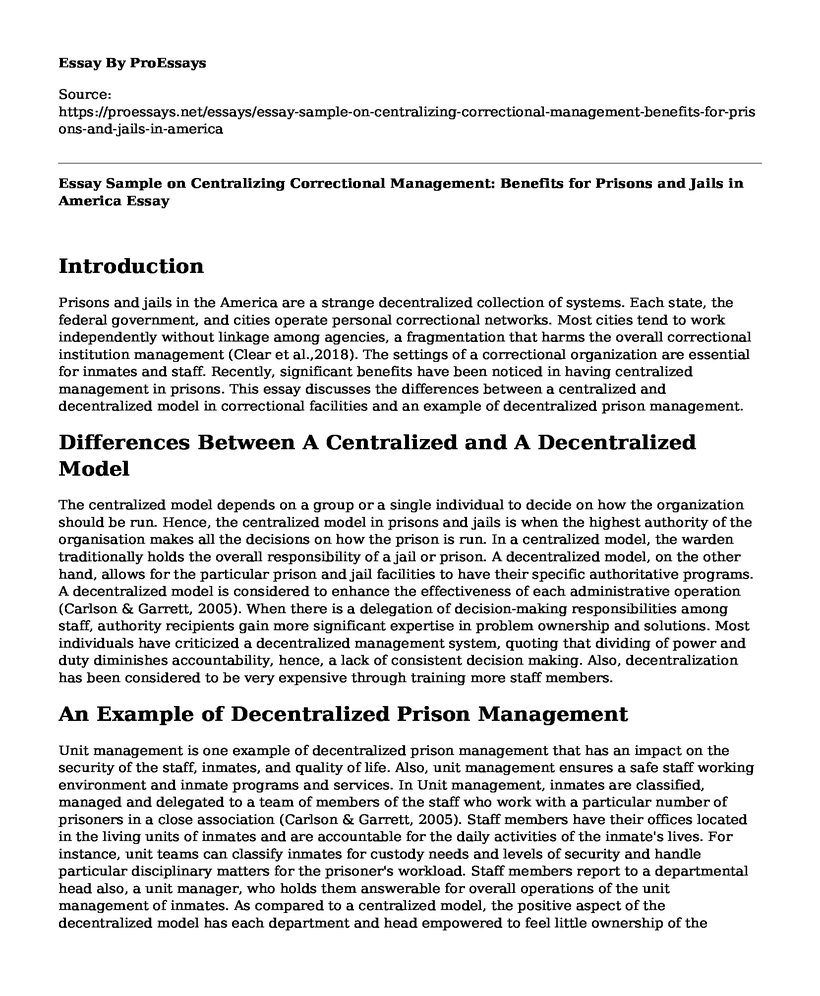Introduction
Prisons and jails in the America are a strange decentralized collection of systems. Each state, the federal government, and cities operate personal correctional networks. Most cities tend to work independently without linkage among agencies, a fragmentation that harms the overall correctional institution management (Clear et al.,2018). The settings of a correctional organization are essential for inmates and staff. Recently, significant benefits have been noticed in having centralized management in prisons. This essay discusses the differences between a centralized and decentralized model in correctional facilities and an example of decentralized prison management.
Differences Between A Centralized and A Decentralized Model
The centralized model depends on a group or a single individual to decide on how the organization should be run. Hence, the centralized model in prisons and jails is when the highest authority of the organisation makes all the decisions on how the prison is run. In a centralized model, the warden traditionally holds the overall responsibility of a jail or prison. A decentralized model, on the other hand, allows for the particular prison and jail facilities to have their specific authoritative programs. A decentralized model is considered to enhance the effectiveness of each administrative operation (Carlson & Garrett, 2005). When there is a delegation of decision-making responsibilities among staff, authority recipients gain more significant expertise in problem ownership and solutions. Most individuals have criticized a decentralized management system, quoting that dividing of power and duty diminishes accountability, hence, a lack of consistent decision making. Also, decentralization has been considered to be very expensive through training more staff members.
An Example of Decentralized Prison Management
Unit management is one example of decentralized prison management that has an impact on the security of the staff, inmates, and quality of life. Also, unit management ensures a safe staff working environment and inmate programs and services. In Unit management, inmates are classified, managed and delegated to a team of members of the staff who work with a particular number of prisoners in a close association (Carlson & Garrett, 2005). Staff members have their offices located in the living units of inmates and are accountable for the daily activities of the inmate's lives. For instance, unit teams can classify inmates for custody needs and levels of security and handle particular disciplinary matters for the prisoner's workload. Staff members report to a departmental head also, a unit manager, who holds them answerable for overall operations of the unit management of inmates. As compared to a centralized model, the positive aspect of the decentralized model has each department and head empowered to feel little ownership of the elements of institutional operations. A centralized model has power structures made by a few individuals in a consistent manner that is safe and secure.
Conclusion
Prisons and jails in America operate under distinct management structures. The most progressive management schemes have instituted their different operations in unified parts that operate efficiently to meet the community goals of confining prisoners and preparing them for a successful release in their societies. Few systems in the United States, including the corrections, the courts, and probation staff, work with felons passing them from one correctional process stage to the next, in a goal-focused manner. It is unfortunate that in most systems, the agencies work together as different units and are typically involved in the prisoner's lives from their isolated notions. Felons are passed on with no continuity of care, and lack of ownership in the failure or success of the general procedure. Many correctional facilities in America are affected by disorganization, which is the biggest gap in the administration of justice.
References
Carlson, P. M., & Garrett, J. S. (2005). Prison and Jail Administration: Practice and Theory. Jones & Bartlett Learning, https://books.google.co.ke/books?hl=en&lr=&id=Lw_gMqvxWkoC&oi=fnd&pg=PR21&ots=IxTuVz5nnY&sig=-uFKskfFLvsJIuIAgCz3pEwt-L0&redir_esc=y#v=onepage&q&f=false
Clear, T. R., Reisig, M. D., & Cole, G. F. (2018). American corrections. Cengage learning, https://books.google.co.ke/books?hl=en&lr=&id=Ja9EDwAAQBAJ&oi=fnd&pg=PP1&dq=Prison+and+Jail+administration+in+America&ots=LhFnyRBwa1&sig=SF-029PkNMfvBQWmge1sUFlowpU&redir_esc=y#v=onepage&q=Prison%20and%20Jail%20administration%20in%20America&f=false
Cite this page
Essay Sample on Centralizing Correctional Management: Benefits for Prisons and Jails in America. (2023, May 09). Retrieved from https://proessays.net/essays/essay-sample-on-centralizing-correctional-management-benefits-for-prisons-and-jails-in-america
If you are the original author of this essay and no longer wish to have it published on the ProEssays website, please click below to request its removal:
- Prevention of Cyber Crime
- Essay Sample on Defense of Property
- Research Paper on Interrogation & Interviewing Techniques for Criminal Case Investigation
- Essay Sample on Coordinated Global Approach Needed to Curtail Cybercrimes in Supply Chain
- Bay Area Housing Crisis: Unjust Violation of Human Rights - Essay Sample
- Paper Sample on Preserving Privacy in Healthcare: Encouraging and Monitoring Patient Information
- Woodrow Hartzog's "Privacy's Blueprint: The Battle to Control the Design of New Technologies"







